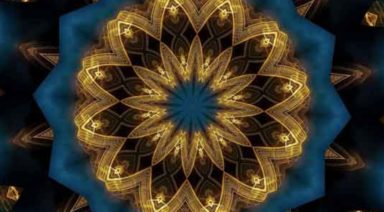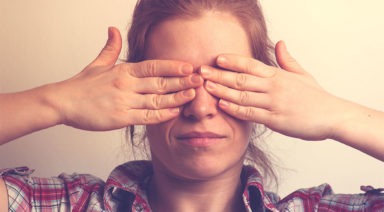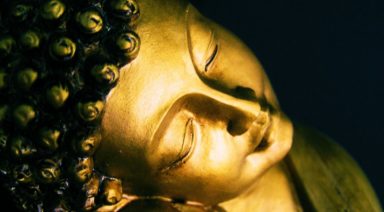5 Tips for a Healthy Thyroid

Do you know about the little butterfly inside of you? Not the one in your stomach that flutters when you are nervous. The one in the middle of your neck; the one that doesn’t get much attention until the doctor puts his/her cold hands around your neck and pokes around. It is called the Thyroid Gland — actually shaped like a butterfly — in front of your throat, underneath your Adam’s apple (yes ladies, you have one too, just smaller).
Let’s get to know the what this tiny gland does. It’s time to get comfortable with the butterflies.
The hormone secreted from this gland is responsible for metabolism, energy, growth and balance of other sex hormones. In yoga, it is associated with the fifth chakra that lies in the same region — the visshudhi chakra — represented by space, sound & the colour blue. In psychology, tightness in this region is associated with feeling unheard, or holding in the unspoken.
The thyroid gland releases a hormone called T4 that turns into T3, which is what is called the physiologically active thyroid hormone. This is not the first hormone measured when a doctor tests your thyroid health.
When we suspect a Hypo (low T4&T3) or Hyper (high T4&T3) thyroid state, the first hormone tested is the Thyroid Stimulating Hormone (TSH), which comes from the pituitary gland in the middle of your brain, not the thyroid. Confusing, huh?
Think of TSH like a distant gatekeeper. If you have enough thyroid hormone doing its job in your body, TSH stays in a normal range. There are autoimmune conditions and other thyroid troubles where the TSH & thyroid hormone are affected by other factors, but for the vast majority of the population, there are two scenarios that are most likely:
Scenario 1
You don’t have enough thyroid hormone to manage metabolism, energy, and growth, causing weight gain, hair loss, dry skin, depression/anxiety—what I call the “slow symptoms”. TSH increases to try and get your thyroid to pump out more hormone because you have Hypothyroid (your TSH has risen when your doctor assesses that you have low thyroid function).
Scenario 2
You have too much Thyroid hormone, causing rapid weight loss, heart palpitations, depression/anxiety—what I call the “fast symptoms”. This can be dangerous! TSH lowers and tries to stop the Thyroid gland from releasing its hormone because you have Hyperthyroid (your has TSH dropped when your doctor assesses that you have an overactive thyroid)
So we check in with the gatekeeper first; we ask TSH to give us the low down on the body’s metabolic state. Usually the direction of TSH is the opposite of Thyroid function. The gatekeeper is trying to balance out T4 & T3 levels.
If these numbers are out of whack, it is important to have a physician help you manage your glandular health.
The thyroid gland does not just lie dormant — it changes with our age, our health, our life situations. It responds to our stress levels, exercise and eating habits. We can heal or harm ourselves with simple changes. With a focused diet, meditation and asana practice, and consultation with a physician, you can choose to heal.
There is no magic elixir that can cure all types of thyroid troubles, but there are simple, at-home practices that can certainly help.
5 Thyroid DIY Tips:
- Eat from the sea: Seaweed is a natural source of Iodine, an important component of the thyroid hormone (The T represents how many iodine molecules are in the hormone). Iodized salt was created to protect non-coastal peoples from thyroid goiters. Cod and halibut are excellent sources of Tryptophan; tryptophan deficiency has been associated with hyperthyroid states. These fish are also high in selenium.
- Eat from the earth: Respect the neglected button mushrooms – one of the best natural sources of Selenium, a crucial mineral in the conversion of T4 to T3 (the active hormone).
- Use the air in your lungs: Sing/Om/Hum—Get some blood flow back into your throat. Let your voice be heard. Let the butterflies fly.
- Sit: A daily meditation practice has been shown to lower cortisol levels, another hormone in cahoots with the thyroid. Frequency of this practice is more important than duration. Sitting can kill you, but sitting can heal you.
- Move your body: Practice these asanas regularly, with proper alignment guidance:
Matsyasana (Fish Pose)
Purvottanasana (Table)
Salamba Sarvangasana (Shoulderstand)
Baddha Konasana (Butterfly)
Balasana (Child’s Pose)
The poses that assist the thyroid are associated with the sea and the butterfly. Now, that’s full circle health.
Why Does Your Mala Necklace Have 108 Beads?

From the yoga studio to a night on the town, people are donning mala bead necklaces around the globe. However, this trend is steeped in meaningful tradition and symbolism. Each mala necklace has 108 beads, and each bead evokes an energetic frequency based on its material, whether stone or seed.
What is the Significance of 108?
The number 108 has a range of significance across many different cultures and disciplines. For example, this number informs the architecture of sacred texts that are central to yoga and eastern philosophy. As a devoted scholar of yoga and tantra, Shiva Rea explains in Tending the Heart Fire, “there are 108 chapters of the Rig Veda, 108 Upanishads and 108 primary Tantras.” And these texts are written in Sanskrit, a language comprising 54 letters, each with a masculine (Shiva) and feminine (Shakti) form, 54 x 2 = 108. Listed below are just a few of the many relationships that carry this number.
Ayurveda and Other Religions
In in the field of Ayurveda, there are 108 sacred places, or marmas, in the body, identifying intersections of matter and consciousness. When manipulated, these points can awaken and align the vital energy. Members of the Vedic tradition see this number as denoting the wholeness of the universe: one represents the solar masculine, zero represents the lunar feminine and eight represents the infinite nature of all things. In the classic japa mala, used in Buddhism and Hinduism, there are 108 beads used for prayer and mantra.
Mathematics and Astronomy
Mathematicians favor the number 108 for its countless patterns and potential divisions. For example, it is divisible by the sum of its parts and most of its proper divisors, making it a semi-perfect number. Through the lens of astronomy, the diameter of the sun is approximately 108 times that of earth and the distance from our planet to its solar star is, on average, 108 times the diameter of the sun. A similar parallel relationship also exists between the earth and the moon.

What is a Mala?
A mala, meaning garland in Sanskrit, evokes a circular, continuous form. In practice, a mala is the devoted offering of repeated cycles (typically in divisors of 108) of mantra japa or yoga asana. Within a mala, there is always a sense of beginning, continuing and completion. Both inside each individual cycle and in the practice as a whole. This three-form (trimurti) quality allows us to embody, in practice, the rhythmic cycles ever-present in the natural universe: creation (srishti), sustaining (sthiti) and destruction (samhara).





































